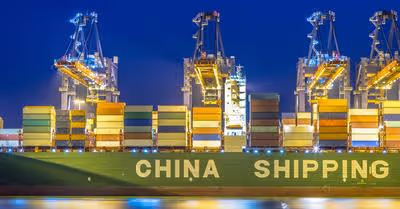
Key Takeaways
- The shipping time from China to the US by boat ranges from 15 to 25 days on average.
- Faster shipping methods are available but more expensive, with air freight being 3-10 days.
- Technological innovations in shipping from China have revolutionized shipping speeds.
China’s competitive manufacturing costs make it an attractive destination for sourcing products. But how long does it take to ship from China by boat?
Shipping by boat from China can typically take anywhere from 15 to 25 days. However, this depends on various elements such as the specific route taken, the shipping method, port congestion, weather conditions, and the time of year.
Over the years, I’ve developed a deep understanding of the intricacies involved in maritime transportation. My expertise allows me to navigate the complexities of shipping routes and operational factors that impact the duration of shipments from China to various destinations worldwide. As such, I’ll provide accurate, reliable, and insightful guidance to help you make informed decisions when it comes to planning your shipping strategies.
Shipping By Boat From China: How Long Does It Take?
You've decided to ship cargo by boat from China and you're twiddling your thumbs, wondering just how long it's going to take.
Typically, shipping by boat from China can take anywhere from 15 to 25 days. This timeframe can vary based on factors like the shipping company, the port of departure in China, the destination port, and how busy these ports are.
Understanding the factors influencing the journey from the warehouse to your doorstep can demystify the process and set realistic expectations.
Let's dive into these specifics.
Distance and Route
- Distance: The physical distance between China and your destination is a no-brainer; shipments to the West Coast of the U.S. are quicker than to the East Coast, taking roughly 15 days and 25 days or more, respectively.
- Route: Various shipping routes, like the shorter Pacific crossing or the longer trek via the Mediterranean, significantly impact transit times.
Transportation Mode
- Ocean Freight: It's the slower but cost-efficient method with choices between Full Container Load (FCL) or Less-than-Container Load (LCL), affecting time.
Weather Conditions
Unpredictable weather can delay shipping, especially when crossing treacherous seas. A clear day in Shanghai can mean a quicker dispatch from the port than when battling a typhoon.
Customs Clearance
- Efficiency: The speed of customs clearance processes at both the port of loading in China and the port of destination in the U.S. can make or break your lead times.
- Documentation: Properly prepared shipping documents like the certificate of origin and proforma invoice influence how fast your goods move through customs.
Port Congestion
Port congestion is a significant challenge faced by major ports worldwide, including Los Angeles. The increased volume of imports, coupled with limited infrastructure capacity and labor shortages, often leads to congestion at ports.
This congestion can result in delays in the offloading and handling of containers, as port terminals struggle to keep up with the influx of cargo.
As a result, shipments may experience longer lead times than anticipated, impacting supply chain efficiency and delivery schedules.
Transshipment and Handling
In some cases, shipments may require transhipment, which involves transferring cargo between vessels or modes of transport during transit.
Transshipment adds a layer of complexity to the shipping process and can contribute to delays in delivery. Efficient freight forwarders employ strategic planning and effective logistics solutions to minimize these delays.
Carrier Schedule and Availability
The schedules of shipping carriers, such as Maersk, play a crucial role in determining the transit time of shipments. However, carrier schedules may not always align with the ideal timeline desired by shippers.
Factors such as vessel availability, route optimization, and peak shipping seasons can impact the frequency and reliability of carrier services. Shippers must carefully consider carrier schedules and availability when planning their shipments to avoid delays and ensure timely delivery.
Working closely with reputable shipping companies and leveraging advanced booking systems can help shippers secure space on preferred vessels and optimize their shipping schedules for maximum efficiency.
Packaging and Documentation Compliance
- Packaging: The correct export packaging not only protects your product designs but also speeds up handling time.
- Compliance: Errors in shipping documents can lead to delays. Getting it right the first time ensures faster movement.
Holidays and Peak Seasons
- Chinese Holidays: Expect delays during Chinese New Year and Golden Week when the entire country, including suppliers and logistics, slows down.
- Peak Seasons: The rush times typically cause longer delivery times due to the surge in volume and freight rates.
How Much Is Shipping from China to the US?
Have you ever wondered about the ins and outs of shipping your goods from China to the bustling markets of the US? It's like planning a grand vacation for your products across the Pacific, and you're the travel agent!
Whether you're an entrepreneur scaling your business or a seasoned importer, understanding the fees tied to ocean or air freight is crucial.
Here's the scoop on what you'll pay to ship your goods from China to the US:
Express shipping with companies like FedEx, DHL, or TNT might speed things up but will require deeper pockets, whereas sea freight is easier on your wallet but tests your patience. You've got choices!
Impact of Technological Innovations on Shipping Time from China
The impact of technological innovations on shipping time from China has been significant, revolutionizing the efficiency and speed of global logistics.
Here's how technological advancements have influenced shipping time:
- Improved Tracking and Visibility: Technological innovations such as GPS tracking systems and advanced logistics software have enhanced visibility into the movement of goods throughout the supply chain.
- Optimized Routing and Planning: Advanced route optimization algorithms and predictive analytics tools enable shipping companies to optimize shipping routes and delivery schedules.
- Automation and Robotics: Automation and robotics have revolutionized many aspects of the shipping industry, from warehousing and inventory management to loading and unloading cargo. Automated systems can significantly reduce processing times and improve the overall speed of cargo handling, leading to faster turnaround times at ports and warehouses.
- Predictive Maintenance: Predictive maintenance technologies utilize sensors and data analytics to monitor the condition of shipping vessels and equipment in real time.
Frequently Asked Questions
Here are the FAQs on shipping from China.
Is there a fast lane when shipping by sea to get my goods from China to the US?
In shipping, though, there's no secret fast lane to whizz your goods across the sea. However, choosing premium services from reputable shippers might save you a few days. It's not magic, just good, efficient logistics.
What might cause my shipment from China to take longer than the estimated delivery time?
Your shipment could take longer due to various reasons such as bad weather, port congestion, customs clearance delays, or operational hiccups with the carrier. It's the nature of the beast, but a little patience goes a long way.
How can I ensure a smooth shipping process from China?
To ensure a smooth shipping process, it's crucial to work with reputable shipping companies, provide accurate and complete shipping documentation, and plan to account for potential delays or issues.










